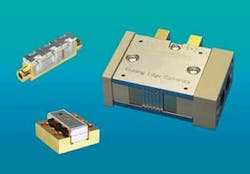Copper-graphene composite: the next laser heat-exchanger material?
Raleigh, NC--At North Carolina State University, assistant professor Jag Kasichainula has created a graphene-based cooling technique for laser diodes and other optoelectronics, as well as for power electronics.1 A composite of graphene in a copper matrix (prepared by electrochemical codeposition from a copper sulfate solution with suspended graphene oxide) shows a thermal conductivity about 25% greater than that of pure copper.
At room temperature, the copper-graphene composite has a thermal conductivity of 380 W/m.K, compared to copper’s 460 W/m.K. The new composite exhibits thermal conductivity of 510 W/m.K at 250 K (–23 C) and 440 W/m.K at 350 K (77 C).
“Both the copper-graphene and indium-graphene have higher thermal conductivity, allowing the device to cool efficiently,” says Kasichainula. “The copper-graphene composite is also low-cost and easy to produce. Copper is expensive, so replacing some of the copper with graphene actually lowers the overall cost.”
(However, if cost is no object, use diamond—it has a thermal conductivity of about 1000 W/m.K.)
REFERENCE:
1. K. Jagannadham, Metallurgical and Materials Transactions B (2012); DOI: 10.1007/s11663-011-9597-z

John Wallace | Senior Technical Editor (1998-2022)
John Wallace was with Laser Focus World for nearly 25 years, retiring in late June 2022. He obtained a bachelor's degree in mechanical engineering and physics at Rutgers University and a master's in optical engineering at the University of Rochester. Before becoming an editor, John worked as an engineer at RCA, Exxon, Eastman Kodak, and GCA Corporation.
